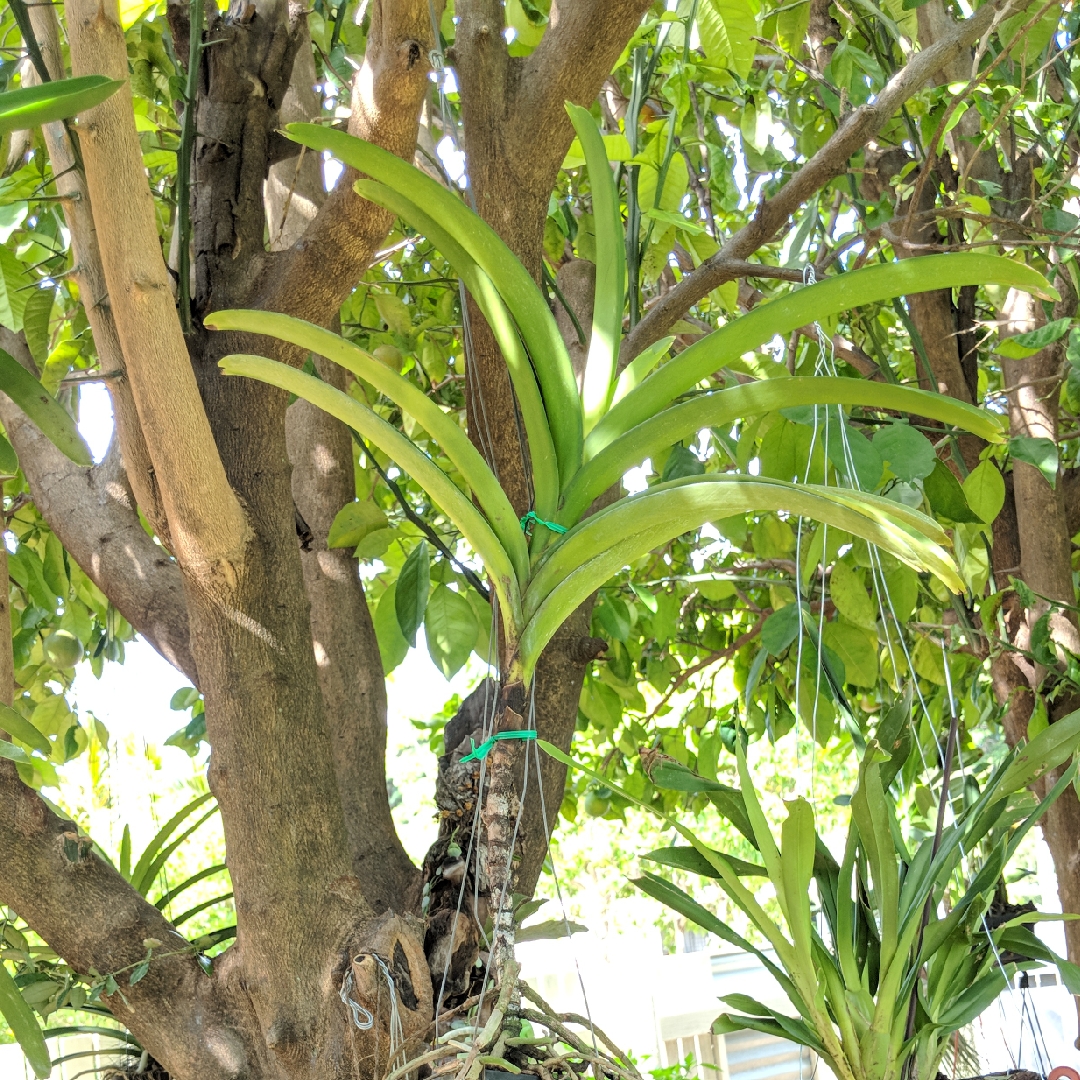
Vanda 'Vivian' x 'Ascocenda Suksamran Gold'
Vanda Orchid 'Vivian' x 'Ascocenda Suksamran Gold'
Vanda orchids are all epiphytic (that is the plant clings to tree-bark). They require consistent conditions, or they are inclined to drop their lower leaves. Neither do they like to have any root-disturbance. Its natural habitat is tropical, and so cultivated plants need high humidity. Vanda orchid plants require temperatures no lower than 55 F. (13 C.) and no higher than 95 F. (35 C.) The aerial roots act as sponges and can absorb a great deal of moisture rapidly. The roots also ensure that the plant remains anchored to the tree on which it is growing, and so there is no need for any growing medium. In fact potting soil causes the roots to rot.They are often grown in wooden baskets with only a small amount of potting compost. The plants range in size from miniature to several feet tall, and the fragrant flowers are in just about every colour, can be small or large, and are borne on spikes of 6-8 blooms. The leaves of Vanda Orchids can be one of three types - strap-leaved, terete and semi-terete - and each has different light requirements. Strap-leaved is self-explanatory, and needs partial shade and protection from bright mid-day light. Terete has a round pencil-shaped leaf, and requires bright light and sun. Semi-terete is in between the two. Ascocentrum x Vanda cross is known as Ascocenda, or Ascda. The Ascocendaplants offer the very best of both their parents: they are compact monopodial plants that can easily be grown indoors; they have the same outrageously awesome growth habit; and they boast the jewel-like flowers of the Vandas.
Contributed by @Amydutz
-
Partial shade
-
Occasional watering
-
Not Frost hardy
-
Moist and free draining
Common name
Vanda Orchid 'Vivian' x 'Ascocenda Suksamran Gold'
Latin name
Vanda 'Vivian' x 'Ascocenda Suksamran Gold'
type
Perennial
family
Orchidaceae
ph
5.0 - 8.0 Acid - Neutral
Plant & bloom calendar
-
Best time to plant
-
When the plant will bloom
full grown dimensions
 0.15 M
1.30 M
0.15 M
1.30 M
Vanda 'Vivian' x 'Ascocenda Suksamran Gold'
Vanda orchids are all epiphytic (that is the plant clings to tree-bark). They require consistent conditions, or they are inclined to drop their lower leaves. Neither do they like to have any root-disturbance. Its natural habitat is tropical, and so cultivated plants need high humidity. Vanda orchid plants require temperatures no lower than 55 F. (13 C.) and no higher than 95 F. (35 C.) The aerial roots act as sponges and can absorb a great deal of moisture rapidly. The roots also ensure that the plant remains anchored to the tree on which it is growing, and so there is no need for any growing medium. In fact potting soil causes the roots to rot.They are often grown in wooden baskets with only a small amount of potting compost. The plants range in size from miniature to several feet tall, and the fragrant flowers are in just about every colour, can be small or large, and are borne on spikes of 6-8 blooms. The leaves of Vanda Orchids can be one of three types - strap-leaved, terete and semi-terete - and each has different light requirements. Strap-leaved is self-explanatory, and needs partial shade and protection from bright mid-day light. Terete has a round pencil-shaped leaf, and requires bright light and sun. Semi-terete is in between the two. Ascocentrum x Vanda cross is known as Ascocenda, or Ascda. The Ascocendaplants offer the very best of both their parents: they are compact monopodial plants that can easily be grown indoors; they have the same outrageously awesome growth habit; and they boast the jewel-like flowers of the Vandas.
Planting
From Early Spring TO Late Winter
Vandas can be grown in plastic pots with sphagnum moss and orchid media, but this is a not ideal. It is better to grow them in a slatted basket, so that the roots can grow through the slats and dangle towards the ground. (They will require more frequent watering, if grown in a slatted basket)
Flowering
From Early Spring TO Late Winter
Flowers can appear several times a year, if the conditions are right, and the flowers can last for 4 - 6 weeks. The stem of the flowers should be cut right back when the flowers have died








